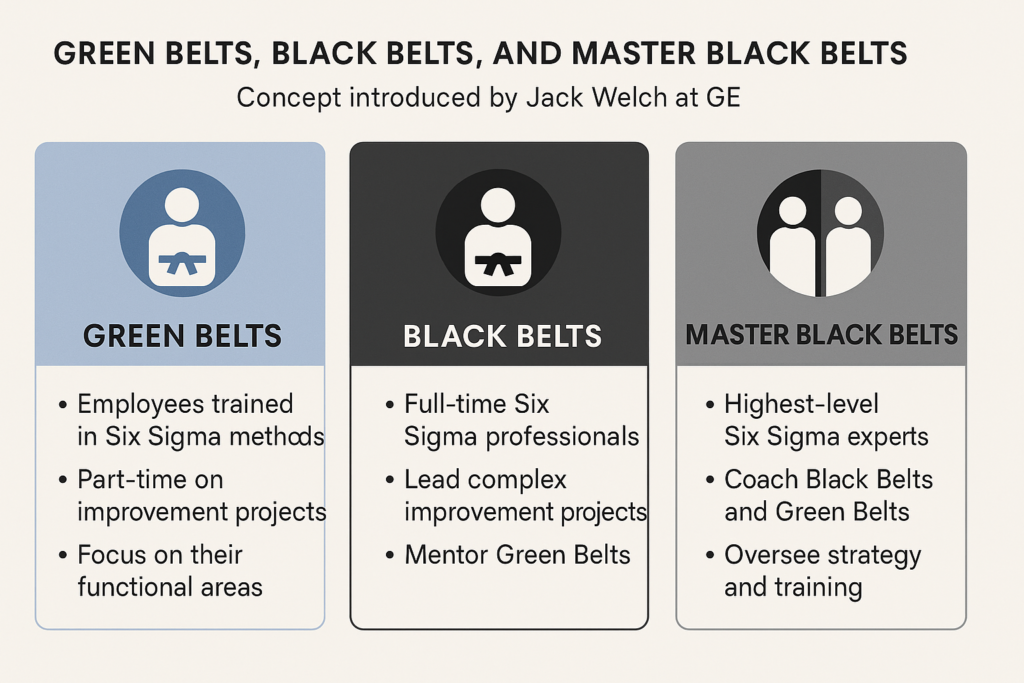The Jack Welch Lexicon of Leadership – The Black Belts – Successful Sales Management (Part 11)

I just completed rereading the book “The Jack Welch Lexicon of Leadership” – The Black Belts.
I had first read it somewhere in 2018, but unfortunately, I hadn’t made any notes. In the re-reading I made it a point to make notes – that too handwritten notes
And one concept which will be forever etched in my memory is the concept of Belts – Green Belts, Black Belts, and Master Black Belts
Before we delve into the concept, for the uninitiated, let me explain Six Sigma
What is Six Sigma?
Six Sigma is a method which companies use to improve the way they work—by reducing errors, improving quality, and saving time and money.
It’s about solving problems using data and logic, not guesswork.
Imagine you are a brand manager in V&V Pharmaceuticals (fictitious name) launching a new pain relief tablet Painjaa (fictitious name).
You notice that in North Gujarat doctors aren’t prescribing Painjaa as forecasted by you.
Instead of guessing the reason, a Six Sigma approach helps you investigate using data.
Maybe the retail pharmacy is not satisfactory, or the District Manager Vidyut Desai has not succeeded in getting the Painjaa strategy implemented well, or maybe your strategy itself hasn’t been communicated well in the local language to the medical representatives of North Gujarat.
Once the problem is clear, you fix the process—so the launch of Painjaa becomes more successful across all the headquarters of North Gujarat.
This structured method was made famous by Jack Welch at GE and is used in industries around the world—including healthcare and pharmaceuticals.
(In the manufacturing sector, the most basic definition, Six Sigma is a statistical representation for what many experts call a “perfect” process. Technically, in a Six Sigma process, there are only 3.4 defects per million opportunities.)
The concepts of Green Belts, Black Belts, and Master Black Belts come from the Six Sigma quality improvement methodology, which was popularized by Jack Welch during his leadership at General Electric (GE) in the 1990s.
So what is this concept? Says Jack Welch:
Green Belts:
- Who they are: Employees trained in basic Six Sigma tools and methodologies.
- Role: They work on improvement projects part-time, often under the guidance of Black Belts.
- Skills: Proficient in tools like DMAIC (Define, Measure, Analyze, Improve, Control), process mapping, and data analysis.
- Focus: Improve processes within their own functional areas (e.g., marketing, operations, finance).
Black Belts:
- Who they are: Full-time Six Sigma professionals.
- Role: Lead complex improvement projects across functions, mentor Green Belts, and drive measurable results.
- Skills: Advanced statistical analysis, project management, leadership.
- Focus: Deliver strategic improvements with high financial impact.
Master Black Belts:
- Who they are: The highest-level Six Sigma experts in the organization.
- Role: Coach Black Belts and Green Belts, oversee project selection, and ensure Six Sigma is aligned with business strategy.
- Skills: Deep expertise in Six Sigma tools, change management, and leadership training.
- Focus: Strategy, training, and governance of the Six Sigma program.

Jack Welch’s Vision at GE:
- Welch embedded Six Sigma as a core part of GE’s culture in the 1990s.
- He required all managers to be Six Sigma certified and drove accountability at every level.
- It led to significant cost savings, quality improvements, and became a model for other corporations.
These learnings from the book are immensely important to me.
Another key learning from the book is the Principle of the 4 E’s of leadership.
The 4 E’s – as per my understanding are a fundamental leadership framework from Jack Welch’s philosophy. Here are the 4 E’s from “The Jack Welch Lexicon of Leadership”:
- Energy: Leaders must demonstrate high personal energy and create an atmosphere that energizes others. This includes physical stamina, mental vigor, and emotional enthusiasm that inspires their teams.
- Energize: Effective leaders don’t just possess energy themselves; they spark excitement and motivation in others. They communicate a compelling vision that gets people engaged and passionate about their work.
- Edge: Leaders need the courage to make tough decisions, including those about people, strategy, and competition. This means having the confidence to take calculated risks and make difficult calls, even when unpopular.
- Execute: The ability to consistently deliver results. This involves translating ideas into action, following through on commitments, and holding oneself and others accountable for performance.
Case Study of V &V Pharmaceuticals
To build a high-performing sales force, V & V Pharmaceuticals can integrate Jack Welch’s 4 Es—Energy, Energize, Edge, and Execution—with the Six Sigma Belt concept to guide development and promotion decisions.
The 4 Es can be used to assess potential: Energy reflects personal drive, Energize measures the ability to inspire others, Edge evaluates decision-making courage, and Execution ensures follow-through.
Simultaneously, a belt-based training model can structure growth:
Green Belts for frontline medical representatives focused on mastering core skills.
Black Belts for the first-line field sales managers with proven ability to lead and solve complex challenges.
Master Black Belts for Regional or Zonal leaders who mentor others and drive transformation.
Promotions should be earned by demonstrating both the 4 Es and belt-level competencies, not tenure alone.
This dual framework ensures that only capable, impact-driven individuals in V & V Pharmaceuticals rise, fostering a culture of merit, continuous learning, and leadership excellence in the field force.